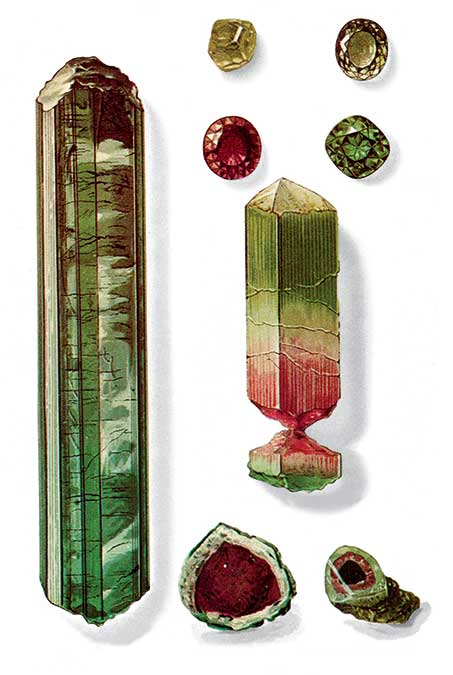Yankee
Maine Tourmaline | Up Close
The word “tourmaline” comes from the Sinhalese tura mali, meaning “stone of mixed colors.” Shades of tourmaline cover the full spectrum and may be bicolored or multicolored. Tourmaline is Maine’s official state mineral. Of the many mineral varieties classified as tourmaline, “elbaite” is the rarest, often made into fine jewelry. Black tourmaline, or “schorl,” is […]

Photo Credit : Gems and Precious Stones of North America by George Frederick Kunz, The Scientific Publishing Co., 1890, reprinted by Dover Publications, Inc., 1968 (plate 4)
The word “tourmaline” comes from the Sinhalese tura mali, meaning “stone of mixed colors.” Shades of tourmaline cover the full spectrum and may be bicolored or multicolored.
Tourmaline is Maine’s official state mineral. Of the many mineral varieties classified as tourmaline, “elbaite” is the rarest, often made into fine jewelry. Black tourmaline, or “schorl,” is the most common but least valuable. Tourmaline and opal are October birthstones.
The first major tourmaline find in North America occurred in 1820. Brown University students Elijah Hamlin and Ezekiel Holmes found a green crystal almost an inch long beneath an uprooted tree on Mount Mica in Paris, Maine.
The famous Hamlin Necklace contains 70 gemstones, most of them tourmalines from the 1820 Mount Mica discovery. It weighs 228 carats and is in the collection of the Mineralogical & Geological Museum at Harvard University.
In 1972, one of the world’s largest deposits of gem tourmaline—a metric ton of pink, green, and watermelon crystals—was discovered on Plumbago Mountain in Newry, Maine. The biggest crystal was 10.6 inches high and up to 3.9 inches wide; dubbed “Jolly Green Giant,” it’s now in the Smithsonian’s collection.
After the Plumbago Mountain discovery, Maine’s Retail Jewelers Association proudly created the “Maine Tourmaline Necklace”: a 24.58-carat pink tourmaline center piece with 23 additional stones and gold panned from the Swift River. Jeweler Addison Saunders of Ellsworth crafted the piece for free. The Maine Tourmaline Necklace was presented on May 25, 1977, to Governor James B. Longley; its appraised value at the time was $25,000. The necklace is kept at the Maine State Museum and is worn on special occasions by Maine’s first ladies.
On September 4, 2009, just 1,000 feet from the historic 1972 find, Plumbago Mountain yielded the “Eureka Find,” a cache of rare blue tourmaline, with some crystals weighing as much as 100 carats.
The mineral band in Maine runs from the Brunswick area on the coast northwest through Auburn and up through Paris and the Oxford Hills to Newry and the New Hampshire border. In recent years, however, a unique mint-green/teal tourmaline, known as SparHawk, was discovered just 28 miles north of Portland.
Maine Mineral Adventures, a roadside attraction off Route 26 in Woodstock, offers rockhound field trips to nearby mines and quarries, including Mount Mica. Or you can sift for treasures (paying by the bucket) through gravel from area mines: digmainegems.com
Several major collections from area mines will soon be exhibited at the Maine Mineral & Gem Museum, currently under construction in Bethel: mainemineralmuseum.org


